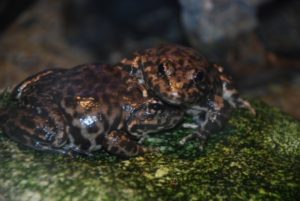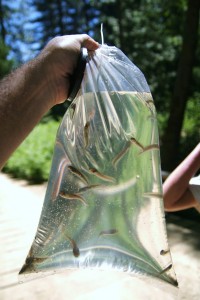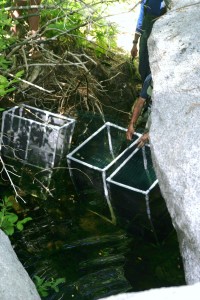It’s not every day that zoo staffers get the chance to return a wild animal back to the wild.
Back in May, we reported that the L.A. Zoo has joined in the effort to repopulate the San Jacinto Mountains near Palm Springs with the native, and horribly endangered, mountain yellow-legged frog, a little amphib that’s been slowly hopping toward extinction for nearly a decade.
Teaming up with Fresno Chaffe Zoo and the San Diego Zoo Institute for Conservation Research, the L.A. Zoo capped off a very successful breeding program this spring with the recent joyous task of releasing an army of 160 yellow-legged wonders back into the wild.
Ready for adventure?
“It’s definitely one of those warm and fuzzy moments,” says Ian Recchio, curator of reptiles and amphibians who has overseen the project for more than a year. “It’s amazing to think that the number of tadpoles we brought to the site was literally more than could be found in the wild right now.”
Indeed, with only a few hundred struggling yellow-legged frogs existing in the wild, these tadpoles are an extremely important key to the species survival.
Hiking in with precious cargo
Recchio accompanied biologists from the U.S. Geological Survey to the future Frogtown where the tadpoles were released near a cold mountain stream, the preferred frog locale. The habitat, says Recchio, has been cleared of potential dangers to the youngins, namely invasive rainbow trout and bullfrogs which enjoy tadpoles for breakfast, lunch, dinner and anytime in between.
Welcome to the new Frogtown
These tadpoles will be tadpoles for a while, says Recchio. Cold mountain frog tadpoles don’t quickly metamorphosis into grown-up hoppers. “They take their time and do things slower,” says Recchio who estimates they probably won’t be full-fledged adult frogs until next year.
Overall, the tadpoles/frogs will be monitored by the U.S. Geological Survey, U.S. Fish and Wildlife Service, California Department of Fish and Game, U.S. Forest Service and the University of California. No doubt, they will be watching to see if the critters are being affected by the potentially fatal infectious Chytrid fungus. Chalk that up as just another hurdle on the path Out Of Extinction for these little guys.
Earlier this year, the Center for Biological Diversity filed a notice with intent to sue the U.S. Fish and Wildlife Service for failing to develop a recovery plan for the frog, adding that federal officials did not take adequate steps under the Endangered Species Act to save the frog from extinction. That lawsuit is still pending.
The release born in captivity at the zoo is the first of potentially many, says Recchio who is now planning for next year’s breeding cycle. The zoo received the mating pairs – six females and four males – last year and by carefully mimicking a mountain environment in a secluded zoo location, Recchio and staff were blessed with 200-300 bouncing baby ‘poles this March.
“We really didn’t know what to expect [in terms of tadpole success] and these many babies just blew us away,” says Recchio.
So soon it will be time to fatten up the females, turn down the lights and chill the tanks for a hibernation period. While it may be hotter than Hades outside, in a quiet small building on zoo property, yellow-legged frogs may very well be dreaming of life beyond bubbling tanks, lawsuits and invasive species. A life of cold-water creeks, plenty of flies and nice soft mud.
— Story by Brenda Rees, photos by Ian Recchio





